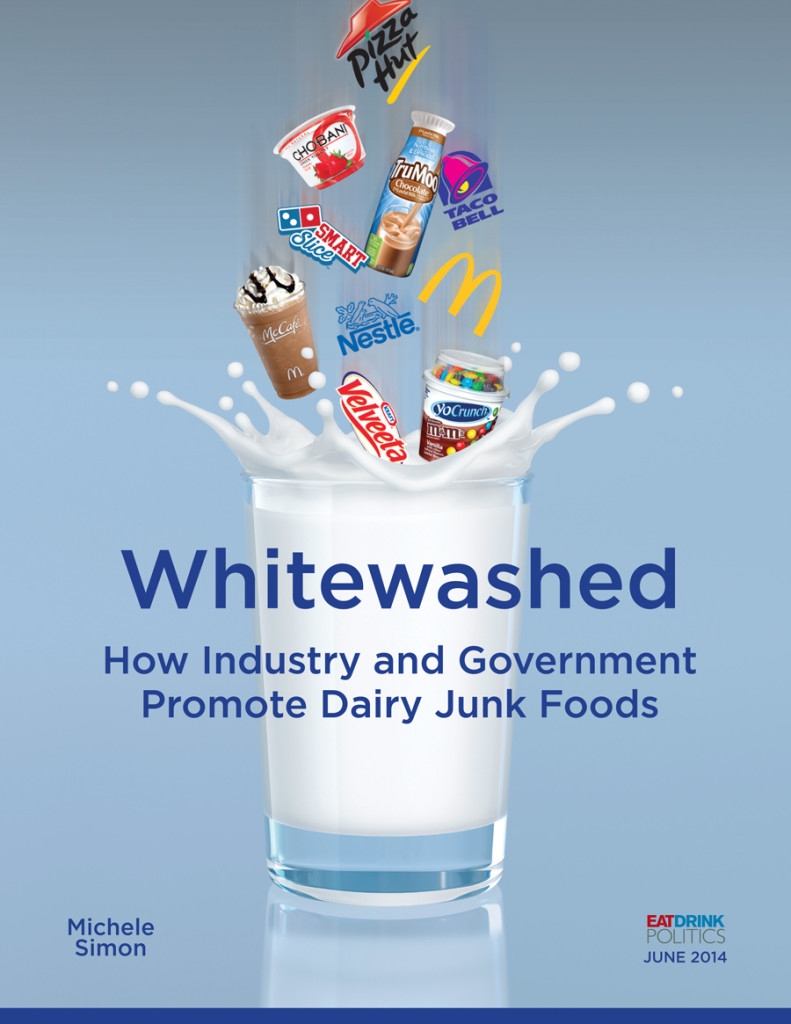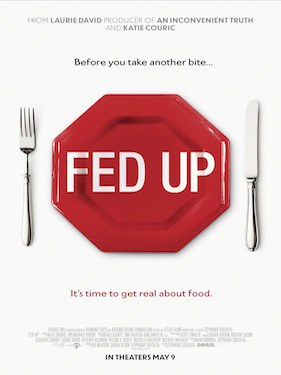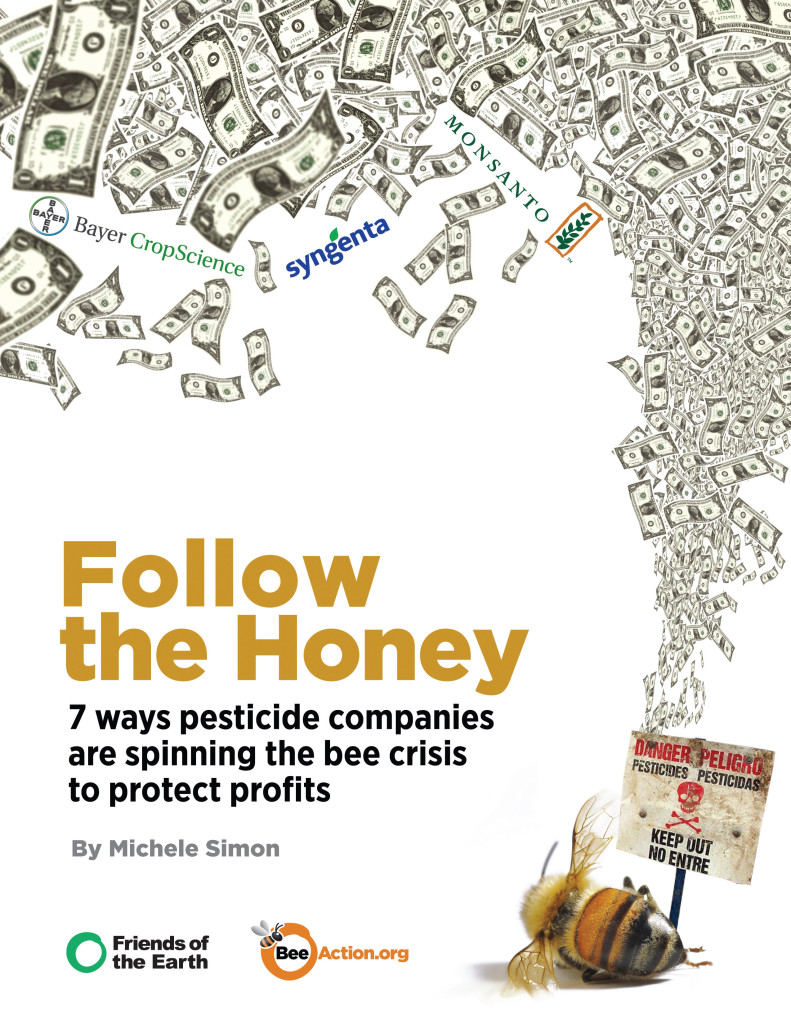
Archive for 2014
Posted on Wednesday, June 11th, 2014 by Michele Simon
 The United States is in the midst of a public health epidemic due to poor diet. While much of the focus has been on obvious culprits such as sugary soft drinks and fast food, dairy foods often get a pass. The dairy industry, propped up by government, has convinced us of the health benefits of milk and other dairy products. But the context of how people consume dairy matters.
The United States is in the midst of a public health epidemic due to poor diet. While much of the focus has been on obvious culprits such as sugary soft drinks and fast food, dairy foods often get a pass. The dairy industry, propped up by government, has convinced us of the health benefits of milk and other dairy products. But the context of how people consume dairy matters.
Continue reading →
Posted in Big Food, Child Nutrition, Food Policy, Industry Tactics, Marketing to Children, Public Health | Tagged: child nutrition, childhood obesity, dairy, deceptive health claims, junk food, school food policy, USDA | Michele on Google+ | View/Add Comments (79) |
Posted on Sunday, May 18th, 2014 by Michele Simon
I have a feature story in the current issue of Experience Life magazine. Here is how the editors introduce the article:
It’s no wonder that most of us are confused. Combine this with dubious ads from the food industry — and the fact that some media outlets may not want to alienate food companies that advertise with them — and we end up with even more muddled information. Overwhelmed, frustrated, and resigned, many of us throw up our hands and eat whatever we want. The good news, however, is that understanding where biased health information comes from can help us sift through the latest headlines and become more intelligent news consumers and smarter shoppers.
You can read the entire article here and listen to the podcast interview here.
Posted in Uncategorized | | Michele on Google+ | View/Add Comments (0) |
Posted on Sunday, May 11th, 2014 by Michele Simon
Am thrilled to be featured in a new powerful film by Laurie David and Katie Couric that features an all-star line-up.

If you search for “Fed Up movie” on Google, the first link you see is not the film’s website, but rather a page from the Grocery Manufacturers Association called “Fed Up Facts“. It’s a silly and desperate attempt by Big Food to respond to the star-power that has Katie Couric appearing all over the mainstream media spreading a message that the food industry doesn’t want you to hear. (GMA denies that “the food industry purposely advertises unhealthy foods to children”. It must happen by accident.)
The film really pulls no punches aiming to dispel the junk food industry’s strongest talking points: it’s all a matter of personal responsibility; we can just exercise our way to health; and we don’t need government regulation. Even Let’s Move is criticized for placing too much emphasis on physical activity and industry partnerships. But as I told the filmmakers, the first lady is in the wrong wing of the White House. (That quote didn’t make the final cut, alas. See this review saying the film lacks policy solutions, which I mostly agree with.)
Continue reading →
Posted in Big Food, Child Nutrition, Industry Tactics, Marketing to Children, Media, Public Health | Tagged: Big Food, childhood obesity, Grocery Manufacturers Association, junk food | Michele on Google+ | View/Add Comments (5) |
Posted on Sunday, April 27th, 2014 by Michele Simon

Today I am releasing a new report with Friends of the Earth, to bring attention to the dire situation of declining bee populations caused by pesticides. You can find the report here, and read a summary below.
If you like to eat, then you should care about what’s happening to bees. Did you know that two-thirds of our food crops require pollination – the very foods that we rely on for healthy eating – such as apples, berries, and almonds, just to name a few. That’s why the serious declines in bee populations are getting more attention, with entire campaigns devoted to saving bees.
A strong and growing body of evidence points to exposure to a class of neurotoxic pesticides called neonicotinoids—the fastest-growing and most widely used class of synthetic pesticides—as a key contributing factor to bee declines.
The European Union banned the three most widely used neonicotinoids, based on strong science indicating that neonics can kill bees outright and make them more vulnerable to pests, pathogens, and other stressors. Enter the corporate spin doctors.
Continue reading →
Posted in Big Food, Food Policy, Industry Tactics | Tagged: bees, Big Food, food safety, lobbying, Monsanto, pesticides | Michele on Google+ | View/Add Comments (6) |
Posted on Friday, April 25th, 2014 by Michele Simon
Today, on behalf of Corporate Accountability International and in collaboration with the Campaign for a Commercial-Free Childhood, I submitted the following comments to the U.S. Department of Agriculture regarding its proposal to require schools to only allow marketing for those foods allowed under the agency’s “Smart Snacks” nutrition guidelines. (See also the excellent comments submitted by Public Health Advocacy Institute on junk food products created for schools.)
Continue reading →
Posted in Child Nutrition, Food Policy | Tagged: advertising regulation, child nutrition, childhood obesity, Corporate Accountability International, junk food, USDA | Michele on Google+ | View/Add Comments (0) |
Posted on Saturday, April 19th, 2014 by Michele Simon
Last month, an unusual scuffle played out between two federal agencies over a controversial proposal by the U.S. Department of Agriculture to increase the speed of kill lines for poultry in slaughterhouses. But with testing from Consumer Reports last year revealing that 97 percent of raw chicken breasts purchased at retailers are contaminated with harmful bacteria, and with poultry workers already suffering from numerous job-related injuries, advocacy groups are vigorously opposed to the idea. The rule would also reduce the number of USDA inspectors required to ensure food safety, transferring some of that responsibility to the chicken and turkey companies themselves. But as one former inspector (who worked both for the USDA and the chicken industry) warned, plant workers are not properly trained for inspection, and they are too scared for their jobs to speak up. That’s why groups such as Food and Water Watch are taking out newspaper ads calling the proposal the “Filthy Chicken Rule.” Read rest at Al Jazeera America …
Posted in Big Food, Food Policy, Food Safety, Industry Tactics, Labor, Public Health | | Michele on Google+ | View/Add Comments (0) |
Posted on Tuesday, March 25th, 2014 by Michele Simon


By Jason Blanchette and Michele Simon
Overconsumption of alcohol remains the third largest cause of preventable death in the United States, causing roughly 88,000 Americans to die prematurely each year. Moreover the costs of alcohol problems to society top $200 billion annually. The alcohol industry, in attempting to deflect blame away from its incessant and exploitative marketing practices, especially to youth, loves to keep the focus on illegal activities such as drunk driving. (Never mind that most alcohol harm stems from disease, crimes, and other forms of injury.)
Continue reading →
Posted in Alcohol Policy, Industry Tactics, Public Health | Tagged: alcohol, Big Alcohol, front groups | Michele on Google+ | View/Add Comments (3) |
Posted on Thursday, March 20th, 2014 by Michele Simon
The food and beverage giant’s new sweetener causes confusion with claims of FDA approval
For years, the processed-food industry has searched in vain for a low-calorie sweetener that actually tastes good, let alone one that retains the flavor profile of the underlying product. In 2010, the food and beverage giant PepsiCo formed an agreement with the flavor company Senomyx to “focus on the discovery, development and commercialization of sweet enhancers and natural high-potency sweeteners.” That partnership appears to be paying off; there is tremendous profit potential for both companies, given the recent dips in soda sales. Which makes the deceptive nature of a recent press release that much more troubling. Read rest at Al Jazeera America …
Posted in Big Food, Food Law, Food Policy, Food Safety, Industry Tactics | Tagged: Big Food, Big Soda, Center for Food Safety, FDA, food safety, junk food, soda, soft drinks | Michele on Google+ | View/Add Comments (0) |
















